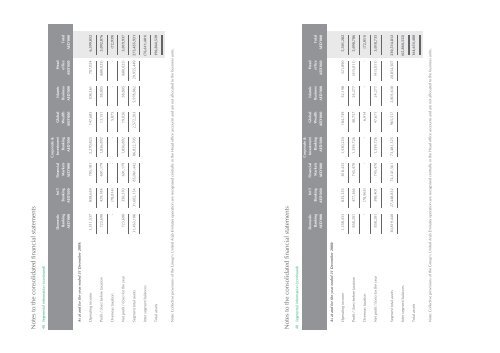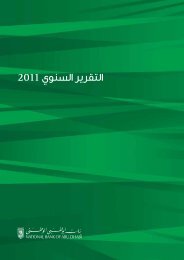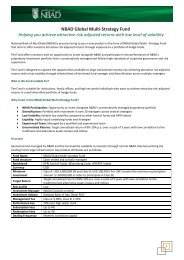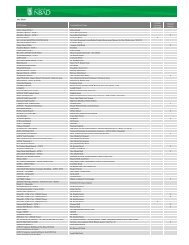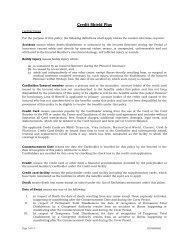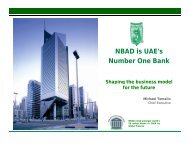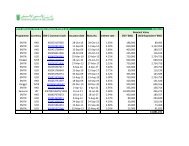English Version - National Bank of Abu Dhabi
English Version - National Bank of Abu Dhabi
English Version - National Bank of Abu Dhabi
Create successful ePaper yourself
Turn your PDF publications into a flip-book with our unique Google optimized e-Paper software.
Notes to the consolidated financial statements<br />
Notes to the consolidated financial statements<br />
3 Significant accounting policies (continued) 3 Significant accounting policies (continued)<br />
ii)<br />
a commodity, which the Group has purchased and<br />
acquired, based on promise received from the customer<br />
to buy the item purchased according to specific terms<br />
and conditions. The selling price comprises the cost <strong>of</strong><br />
the commodity and an agreed pr<strong>of</strong>it margin.<br />
Mudaraba<br />
A contract between the Group and a customer, whereby<br />
one party provides the funds (Rab Al Mal) and the<br />
other party (the Mudarib) invests the funds in a project<br />
or a particular activity and any generated pr<strong>of</strong>its are<br />
distributed between the parties according to the pr<strong>of</strong>it<br />
shares that were pre- agreed upon in the contract.<br />
The Mudarib is responsible <strong>of</strong> all losses caused by his<br />
misconduct, negligence or violation <strong>of</strong> the terms and<br />
conditions <strong>of</strong> the Mudaraba; otherwise, losses are borne<br />
by Rab Al Mal.<br />
Wakala<br />
An agreement whereby the Group provides a certain<br />
sum <strong>of</strong> money to an agent (Wakkil) who invests it in<br />
Sharia’s compliant transactions according to specific<br />
conditions in return for a certain fee (a lump sum <strong>of</strong><br />
money or a percentage <strong>of</strong> the amount invested).<br />
Revenue recognition<br />
Ijara<br />
Income from Ijara is recognised on a declining-value<br />
basis, until such time a reasonable doubt exists with<br />
regard to its collectability.<br />
Murabaha<br />
Income from Murabaha is recognised on a decliningvalue<br />
basis, until such time a reasonable doubt exists<br />
with regard to its collectability.<br />
Wakala<br />
Estimated income from Wakala is recognised on an<br />
accrual basis over the period, adjusted by actual income<br />
when received. Losses are accounted for on the date <strong>of</strong><br />
declaration by the agent.<br />
Mudaraba<br />
Income or losses on Mudaraba financing are recognised<br />
on an accrual basis if they can be reliably estimated.<br />
Otherwise, income is recognised on distribution by the<br />
Mudarib, whereas the losses are charged to income on<br />
their declaration by Mudarib.<br />
(h) Non-trading investments<br />
(i)<br />
Included in non-trading investments are available for<br />
sale assets which are initially recognised at fair value<br />
plus incremental transaction costs directly attributable<br />
to the acquisition.<br />
After initial recognition, these investments are<br />
remeasured at fair value. For investments which are<br />
not part <strong>of</strong> an effective hedge relationship, unrealised<br />
gains or losses are recognised in other comprehensive<br />
income until the investment is derecognised or until the<br />
investment is determined to be impaired, at which time<br />
the cumulative gain or loss previously recognised in other<br />
comprehensive income, is included in the consolidated<br />
income statement for the year. For investments which<br />
are part <strong>of</strong> an effective fair value hedge relationship,<br />
any unrealised gain or loss arising from a change in fair<br />
value is recognised directly in the consolidated income<br />
statement to the extent <strong>of</strong> the changes in fair value being<br />
hedged.<br />
For the purpose <strong>of</strong> recognising foreign exchange gains<br />
and losses, a monetary available for sale financial asset<br />
is treated as if it were carried at amortised cost in the<br />
foreign currency. Accordingly, for such a financial asset,<br />
exchange differences are recognised in the consolidated<br />
income statement.<br />
For unquoted equity investments where fair value<br />
cannot be reliably measured, these are carried at cost<br />
less provision for impairment in value. Upon subsequent<br />
derecognition, the pr<strong>of</strong>it or loss on sale is recognised in<br />
the consolidated income statement for the year.<br />
Included in non-trading investments are held-tomaturity<br />
assets which are carried at amortised cost less<br />
impairment.<br />
Reverse repurchase agreements<br />
Assets purchased with a simultaneous commitment<br />
to resale at a specified future date (reverse repos) are<br />
not recognised. The amount paid to the counterparty<br />
under these agreements is shown as reverse repurchase<br />
agreements in the consolidated statement <strong>of</strong> financial<br />
position. The difference between purchase and resale<br />
price is treated as interest income and accrued over the<br />
life <strong>of</strong> the reverse repurchase agreement and charged to<br />
the consolidated income statement using the effective<br />
(j)<br />
(i)<br />
ii)<br />
interest method.<br />
Premises and equipment<br />
Recognition and measurement<br />
All items <strong>of</strong> premises and equipment are measured at<br />
cost less accumulated depreciation and impairment<br />
losses, if any. Capital projects in progress are initially<br />
recorded at cost, and upon completion are transferred to<br />
the appropriate category <strong>of</strong> premises and equipment and<br />
thereafter depreciated.<br />
Cost includes expenditures that are directly attributable<br />
to the acquisition <strong>of</strong> the asset. Purchased s<strong>of</strong>tware that is<br />
integral to the functionality <strong>of</strong> the related equipment is<br />
capitalised as part <strong>of</strong> that equipment.<br />
Gains and losses on disposal <strong>of</strong> an item <strong>of</strong> property,<br />
plant and equipment are determined by comparing<br />
the proceeds from disposal with the carrying amount<br />
<strong>of</strong> property, plant and equipment and are recognised<br />
net within other operating income in the consolidated<br />
income statement.<br />
Depreciation<br />
Depreciation is recognised in the consolidated income<br />
statement on a straight-line basis over the estimated<br />
useful lives <strong>of</strong> all premises and equipment. Freehold<br />
land and capital work in progress are not depreciated.<br />
The estimated useful lives <strong>of</strong> assets for the current and<br />
comparative period are as follows:<br />
Buildings<br />
Office furniture and equipment<br />
Alterations to premises<br />
Safes<br />
Computer systems and equipment<br />
Vehicles<br />
20 years<br />
1 to 5 years<br />
4 years<br />
10 to 20 years<br />
3 to 7 years<br />
3 years<br />
Depreciation methods, useful lives and residual values<br />
are reassessed at the reporting date.<br />
(iii) Impairment<br />
The carrying amounts are reviewed at each reporting<br />
date for indication <strong>of</strong> impairment. If any such indication<br />
exists then the asset’s recoverable amount is estimated.<br />
The recoverable amount <strong>of</strong> an asset or cash generating<br />
unit is the greater <strong>of</strong> its value in use and its fair value<br />
less costs to sell. In assessing value in use, the estimated<br />
future cash flows are discounted to their present value<br />
using a discount rate that reflects current market<br />
assessments <strong>of</strong> the time value <strong>of</strong> money and the risks<br />
specific to the asset. An impairment loss is recognised<br />
in the consolidated income statement to the extent that<br />
carrying values do not exceed the recoverable amounts.<br />
(k) Collateral pending sale<br />
Non-financial assets acquired in settlement <strong>of</strong> loans and<br />
advances are recorded as assets held for sale and reported<br />
in “Other assets”. The asset acquired is recorded at the<br />
lower <strong>of</strong> its fair value less costs to sell and the carrying<br />
amount <strong>of</strong> the loan (net <strong>of</strong> impairment allowance) at the<br />
date <strong>of</strong> exchange. No depreciation is provided in respect<br />
<strong>of</strong> assets held for sale. Any subsequent write-down <strong>of</strong> the<br />
acquired asset to fair value less costs to sell is recorded<br />
as an impairment loss and included in the consolidated<br />
income statement. Any subsequent increase in the fair<br />
value less costs to sell, to the extent this does not exceed<br />
the cumulative impairment loss, is recognised in the<br />
consolidated income statement. The Group’s collateral<br />
disposal policy is in line with the respective regulatory<br />
requirement <strong>of</strong> the regions in which the Group operates.<br />
(l) Due to banks, customers’ deposits, Euro commercial<br />
paper and medium-term borrowings<br />
Due to banks, customer deposits, Euro commercial paper<br />
and medium-term borrowings are initially recognised at<br />
their fair value plus transaction costs and subsequently<br />
measured at their amortised cost using the effective<br />
interest method.<br />
(m) Repurchase agreements<br />
Assets sold with a simultaneous commitment to<br />
repurchase at a specified future date (repos) are not<br />
derecognised. The liability to the counterparty for<br />
amounts received under these agreements is shown as<br />
repurchase agreements with banks in the consolidated<br />
statement <strong>of</strong> financial position. The difference between<br />
sale and repurchase price is treated as interest expense<br />
and accrued over the life <strong>of</strong> the repurchase agreement<br />
and charged to the consolidated income statement using<br />
the effective interest method.<br />
(n) Subordinated convertible notes<br />
Subordinated convertible notes that can be converted<br />
into share capital at the option <strong>of</strong> the holder, where the<br />
number <strong>of</strong> shares issued do not vary with changes in<br />
51


